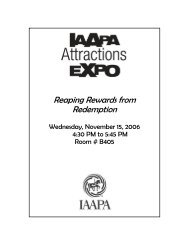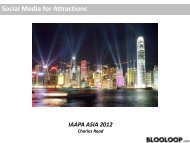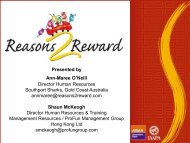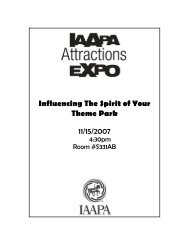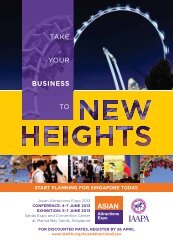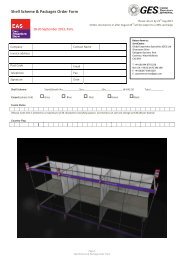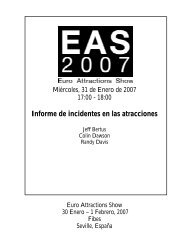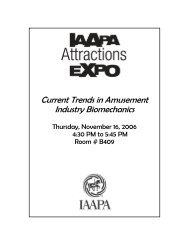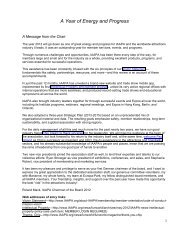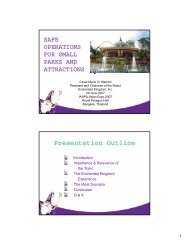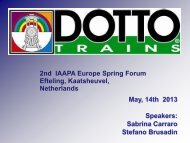2010 Kuala Lumpar Handouts\Melvin Tan_WRS Goin ... - IAAPA
2010 Kuala Lumpar Handouts\Melvin Tan_WRS Goin ... - IAAPA
2010 Kuala Lumpar Handouts\Melvin Tan_WRS Goin ... - IAAPA
You also want an ePaper? Increase the reach of your titles
YUMPU automatically turns print PDFs into web optimized ePapers that Google loves.
ABOUT (<strong>WRS</strong>) WILDLIFE RESERVES SINGAPORE<br />
<strong>WRS</strong> is the holding company of Jurong Bird Park, Night Safari, Singapore Zoo and the<br />
upcoming River Safari (scheduled for completion in 2012).<br />
In 2009, the 3 parks received some 3.6 million visitors.<br />
<strong>WRS</strong> is committed to environmental, health and safety thru:<br />
Complying with applicable legislation<br />
Adopting the best practices and continually improving the environmental, health and<br />
safety standard to prevent pollution, injury and ill health, conserve nature and protect<br />
our wildlife and environment.<br />
Reducing, re-using and re-cycling of resources; and<br />
Educating on nature conservation.<br />
Environmental Conservation & Protection
Environmental Conservation & Protection<br />
<strong>Kuala</strong> Lumpur<br />
Singapore
Environmental Conservation & Protection<br />
2012
Animal Population in <strong>WRS</strong><br />
Area<br />
Species<br />
Specimens<br />
%<br />
Threatened<br />
Species<br />
% CITES<br />
Species<br />
Singapore<br />
Zoo<br />
28 hectare<br />
306<br />
3780<br />
36.2%<br />
47.3%<br />
Night<br />
Safari<br />
40 hectare<br />
122<br />
1994<br />
33%<br />
36%<br />
Jurong<br />
BirdPark<br />
20 hectare<br />
380<br />
4648<br />
48%<br />
51%<br />
Environmental Conservation & Protection
Captive Breedings<br />
• 375 successful births for 35 endangered<br />
species since 2000<br />
Environmental Conservation & Protection
Captive Breedings<br />
Environmental Conservation & Protection
Captive Breedings<br />
Red-tailed Black Cockatoo<br />
Palm<br />
Cockatoo<br />
Red-fronted Macaw<br />
Conservation & Research
DISCUSSION OUTLINE ON GOING GREEN<br />
• Sustainable Design Development<br />
• Recycling Efforts<br />
• Green Initiatives/Programs<br />
• Future Green Strategies<br />
Environmental Conservation & Protection
Sustainable Design Development<br />
- Planting Programs<br />
One of the best ways to help the environment is to have a planting program.<br />
Last year, our parks planted some 45,000 plants, of which 4,000 are trees for the<br />
following purposes:<br />
Sustainable Design Development
Sustainable Design Development<br />
- Planting Programs<br />
• Greening up the parks<br />
Singapore zoo and Night Safari<br />
Jurong Bird Park<br />
Sustainable Design Development
Sustainable Design Development<br />
- Planting Programs<br />
• Showcase co-relationships between plants and animals<br />
Sustainable Design Development
Sustainable Design Development<br />
- Planting Programs<br />
• Create remarkable experience<br />
for the guests & inspire them to care<br />
for wildlife & environment<br />
Sustainable Design Development
Sustainable Design Development<br />
- Planting Programs<br />
• Provide green connectivity for wildlife so that the indigenous forest,<br />
and the ecological functions it supports are retained.<br />
Landscape fragmentation contributes to loss of migratory corridors, loss of connectivity<br />
and natural communities, which all lead to a loss of biodiversity for a region<br />
Sustainable Design Development
Sustainable Design Development<br />
- Planting Programs<br />
• Increases wildlife population<br />
Sustainable Design Development
Sustainable Design Development<br />
- Planting Programs<br />
• Reduce temperature and offset carbon footprint<br />
Sustainable Design Development
Sustainable Design Development<br />
- Planting Programs<br />
• Help to clean airborne toxins from vehicle emissions<br />
as well as soil borne toxins<br />
Sustainable Design Development
Sustainable Design Development<br />
- Tree Protection System<br />
Sustainable Design Development
Sustainable Design Development<br />
- Tree Protection System<br />
Large trees are the backbones of<br />
our rainforests hence are protected with<br />
LPS (Lightning Protection System)<br />
to prevent damage from lightning strike<br />
Sustainable Design Development
Sustainable Design Development<br />
- Transplanting of trees that are affected by development<br />
Sustainable Design Development
Sustainable Design Development<br />
- Green Roofs and Green Vertical wall to<br />
reduce island heat effect<br />
Sustainable Design Development
Sustainable Design Development<br />
- Water catchment for irrigation<br />
This pond shows how rainwater and surface run offs are collected,<br />
impurifies by layers of undergrowth and used for irrigation<br />
Sustainable Design Development
Sustainable Design Development<br />
- Planting of native plant species; requires less watering, getting by on rain water<br />
Sustainable Design Development
Sustainable Design Development<br />
- Pesticide free program; to keep the natural eco system in balance<br />
- kept robust & bug resistant selected hardy plant species<br />
Sustainable Design Development
Sustainable Design Development<br />
- Timber collected from construction sites, boulders from highway construction, tree trunks from tree<br />
cutters, old railway sleepers are being recycled into useful materials for landscaping<br />
Sustainable Design Development
From waste to wonderful landscape…..<br />
Sustainable Design Development
From waste to wonderful landscape…..<br />
Sustainable Design Development
From waste to useful perches and furnitures…..<br />
Sustainable Design Development
These features are built using<br />
recycled timber from construction<br />
sites and structures. This greatly<br />
reduces the need for fresh lumber,<br />
and helps to save our region’s<br />
natural rainforests.<br />
Sustainable Design Development
Features created from discarded logs, tree trunks etc…<br />
Sustainable Design Development
Recycling Programs ~ Waste water is treated before pumping out to sea<br />
Aerobic wastewater treatment to handle about 65 cubic metres of sludge monthly<br />
Recycling Programs
Recycling Programs ~ Horticultural waste & animal dung<br />
Woodchip<br />
Animal Dung<br />
Horticultural waste<br />
Recycling Programs
Recycling Programs ~ Horticultural waste as mulch & animal barriers<br />
Recycling Programs
Recycling Programs ~ <strong>Goin</strong>g Green in F&B<br />
Corn & Yam box Recycle bag Metal cutlery<br />
Work with supplier to collect & recycle tin<br />
can,plastic and glass.<br />
Recycling Programs
Recycling Programs ~ <strong>Goin</strong>g Green in the Office<br />
• Photocopier paper is made of sugar cane fibre<br />
• Duplex printing machine – set to print on both sides<br />
• Recycle paper – shred to provide bedding materials<br />
for some animals<br />
Recycling Programs
Recycling Programs ~ Old Phone recycle program<br />
Recycling Programs
Recycling Programs ~ Recyclable Arts<br />
Recycling Programs
Energy Saving Programs - Evironmental friendly transport systems<br />
Energy Saving Programs
Energy saving devices – motion sensors for lights, fans & flushing systems<br />
Energy Saving Programs
Energy saving devices – light tubes instead of electrically powered lights<br />
Energy Saving Programs
Energy saving practices - all office staff on 5-day week<br />
- lights & a/c are turned off during lunch break<br />
- a/c system is set at 26 degrees & automatically<br />
shut off at 6pm<br />
Energy Saving Programs
Energy saving practices – pumps for waterfalls & cascades are automatically<br />
switched on at 8.30am & off at 6.30pm<br />
Energy Saving Programs
Green Initiatives/Programs<br />
1.Outreach Programs to Schools<br />
School talks and road shows by education officers<br />
Conservation outreach roadshow at Ngee Ann and Temasek Polytechnic<br />
Green Programs
2. Conservation Ambassador Programs<br />
- reconnects students with wildlife thru training & first hand experiences with animals<br />
- play an active role in raising awareness & spread message to visitors the importance of wildlife &<br />
conservation<br />
Green members teaching the public how to plant a tree<br />
and using recycled paper to do origami.<br />
Green Programs
2. Conservation Ambassador Programs<br />
~ Eco Trail<br />
Station 1 – Plant for Life<br />
Objectives of the Eco Trail:<br />
• create greater awareness<br />
about conservation of<br />
wildlife and its habitats<br />
• promote knowledge on<br />
environmental issue to<br />
schools through<br />
participation at various<br />
activity stations in the zoo<br />
Objective<br />
Introduce the importance of flora & fauna and encourage planting<br />
Station 2 – Spotting Wildlife<br />
Objective<br />
Introduce local animal species to the students<br />
Green Programs
2. Conservation Ambassador Programs<br />
Station 3 – Recycling is the way to go!<br />
Station 4 – Reduce energy usage<br />
Objective<br />
•To inculcate recycling culture amongst youngsters<br />
Station 5 – Composting is fun!<br />
Objective<br />
•Encourage participants to practice energy efficiency<br />
Objective<br />
•To introduce composting to participants<br />
Green Programs
3. Promote local stewardship such as<br />
forest & coastal clean ups<br />
Night<br />
Safari<br />
Singapore<br />
Zoo<br />
Green Programs – Earth Day
3. Promote local stewardship such as<br />
coastal & forest clean ups<br />
Coastal cleanup at Pandan<br />
Mangroves.<br />
Green Programs – Earth Day
4. Tree Planting on Earth Day in recognition that deforestation<br />
not only affects animals’ habitats but also affects climate<br />
change<br />
Green Programs – Earth Day
4. Tree Planting on Earth Day at Jurong Bird Park<br />
Green Programs – Earth Day
5. Establish green team ~ create internal staff awareness<br />
Green Programs
5. Establish green team ~ internal staff awareness<br />
• Talks on wildlife<br />
• Wildlife Photography contest<br />
• Eco walk<br />
“Travel to the Wild” and “Let’s go Wild”<br />
Wildlife Photography Challenge<br />
Green Programs
6. Recurring Messages within Exhibits / Proper<br />
~ Pangolin Conservation Panel<br />
Green Programs
6. Recurring Messages within Exhibits / Proper<br />
~ Pangolin Conservation Panel<br />
Green Programs
6. Recurring Messages Outside the Parks<br />
~ Tiger Conservation program @ Istana<br />
Green Programs
6. Recurring Messages Outside the Parks<br />
~ Tiger Conservation program @ Istana<br />
Green Programs
7. E-blasts Quarterly Newsletter<br />
Green Programs
Future Strategies : The Next Green Milestone for <strong>WRS</strong><br />
a. ISO 14064 Greenhouse Gas Emission Reduction<br />
b.BCA Greenmark Assessment for River Safari Park; aiming for a<br />
Platinum Award which is the highest available accolade for<br />
sustainable design in Singapore<br />
Next Green milestones
The Next Green Milestone for <strong>WRS</strong><br />
a. ISO 14064 Implementation at <strong>WRS</strong> to reduce greenhouse gas<br />
emission<br />
Three key greenhouse gases will be covered :<br />
• Carbon dioxide<br />
• Methane<br />
• Hydrofluorocarbon<br />
Next Green Milestones
The Next Green Milestone for <strong>WRS</strong><br />
b. BCA Greenmark Assessment for River Safari Park; aiming for a<br />
Platinum Award which is the highest available accolade for<br />
sustainable design in Singapore<br />
Next Green Milestones
Biodiversity (fauna & flora) survey<br />
Greenmark Assessment – key criterias
Bioswales to collect rainwater, as filtration, & habitat for<br />
native frogs and insects<br />
Greenmark Assessment – key criterias
Implement vertical green wall, to reduce “heat island effect”<br />
Greenmark Assessment – key criterias
Greenroofs – to reduce heat island effect<br />
Waterways – to attract wild life and water filtration<br />
Green roof<br />
Waterways<br />
Greenmark Assessment – key criterias
Greenmark Assessment – key criterias<br />
Greenroof Plan for River Safari<br />
ROTW-Roof Plan
Rainwater harvesting for irrigation<br />
Greenmark Assessment – key criterias
Extensive landscaping<br />
• 120 plant species<br />
• 150,000 plants to be planted<br />
Greenmark Assessment – key criterias
Reuse soil from excavation works & Relocate trees that are<br />
affected by development<br />
Greenmark Assessment – key criterias
Conclusion…..<br />
“Our generation has inherited an incredible beautiful world from our parents<br />
and they from their parents. It is in our hands whether our children and<br />
their children inherit the same world” – Richard Branson
THANK YOU!




